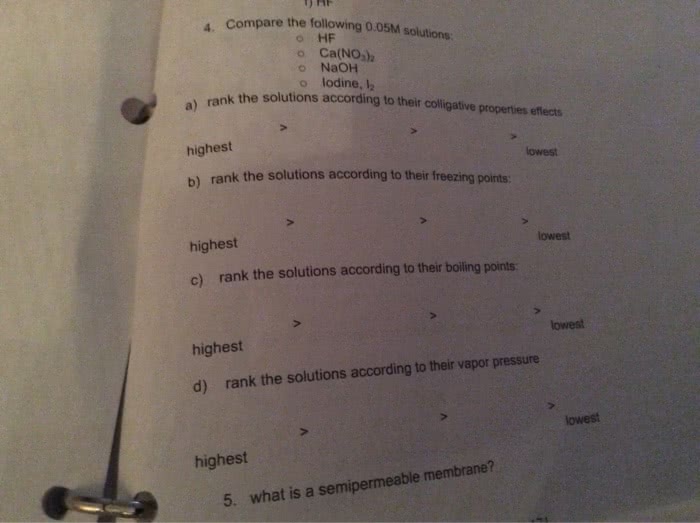Four liquids are described in the table below. Use the second column of the table to explain the order of their freezing points, and the third column to explain the order of their boiling points.
For example, select '1' in the second column next to the liquid with the lowest freezing point. Select '2' in the second column next to the liquid with the next higher freezing point, and so on. In the third column, select '1' next to the liquid with the lowest boiling point, '2' next to the liquid with the next higher boiling point, and so on.
Note: the density of water is /1.00gmL .
solution freezing point boiling point 6.5 g of potassium iodide (KI) dissolved in 100. mL of water (choose one) 1(lowest) 2 3 4(highest) (choose one) 1(lowest) 2 3 4(highest) 6.5 g of potassium chloride (KCl) dissolved in 100. mL of water (choose one) 1(lowest) 2 3 4(highest) (choose one) 1(lowest) 2 3 4(highest) 6.5 g of ethylene glycol (C2H6O2) dissolved in 100. mL of water (choose one) 1(lowest) 2 3 4(highest) (choose one) 1(lowest) 2 3 4(highest) 100. mL of pure water
Four liquids are described in the table below. Use the second column of the table to explain the order of their freezing points, and the third column to explain the order of their boiling points.
For example, select '1' in the second column next to the liquid with the lowest freezing point. Select '2' in the second column next to the liquid with the next higher freezing point, and so on. In the third column, select '1' next to the liquid with the lowest boiling point, '2' next to the liquid with the next higher boiling point, and so on.
Note: the density of water is /1.00gmL .
solution freezing point boiling point 6.5 g of potassium iodide (KI) dissolved in 100. mL of water (choose one) 1(lowest) 2 3 4(highest) (choose one) 1(lowest) 2 3 4(highest) 6.5 g of potassium chloride (KCl) dissolved in 100. mL of water (choose one) 1(lowest) 2 3 4(highest) (choose one) 1(lowest) 2 3 4(highest) 6.5 g of ethylene glycol (C2H6O2) dissolved in 100. mL of water (choose one) 1(lowest) 2 3 4(highest) (choose one) 1(lowest) 2 3 4(highest) 100. mL of pure water




